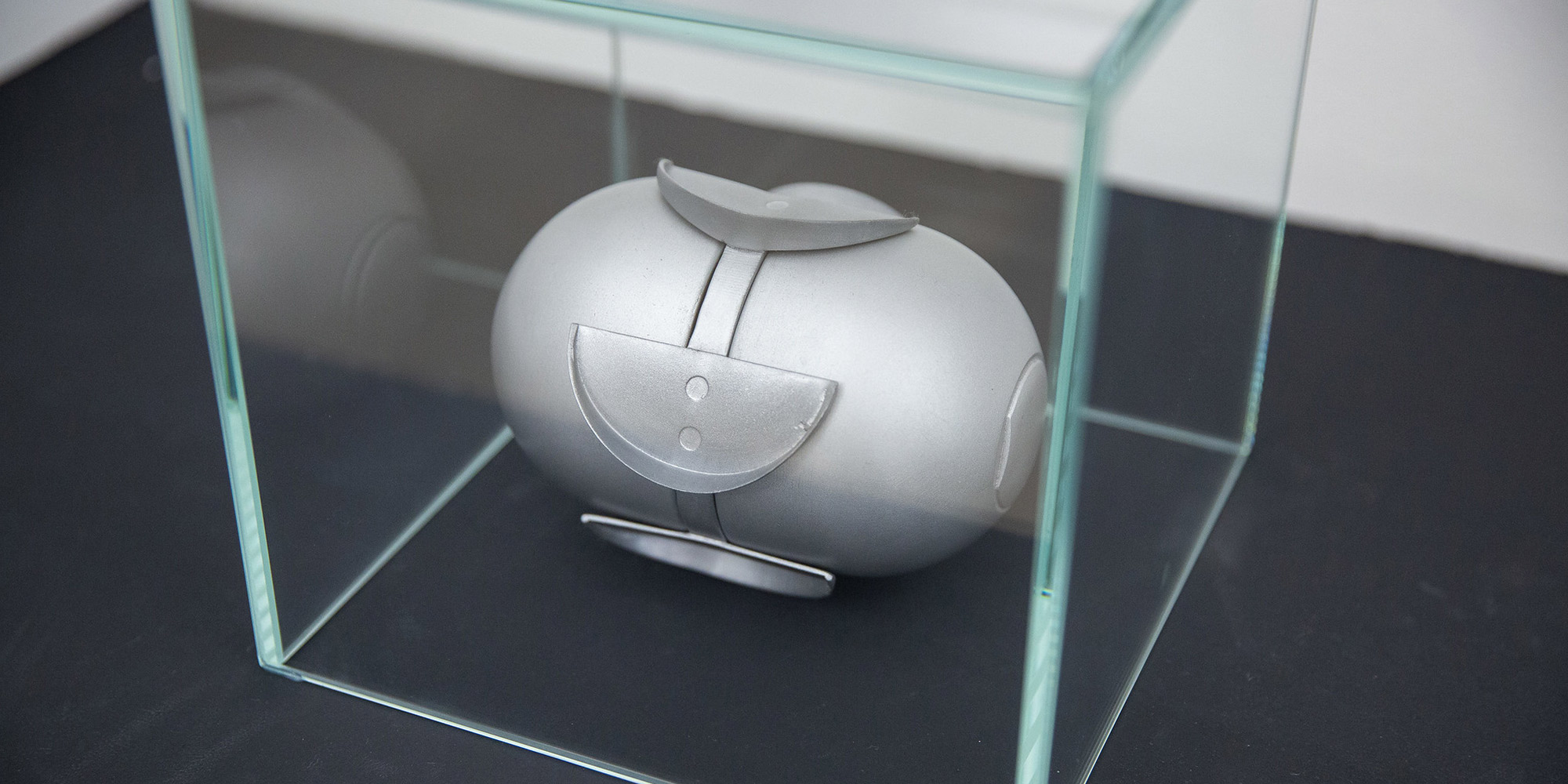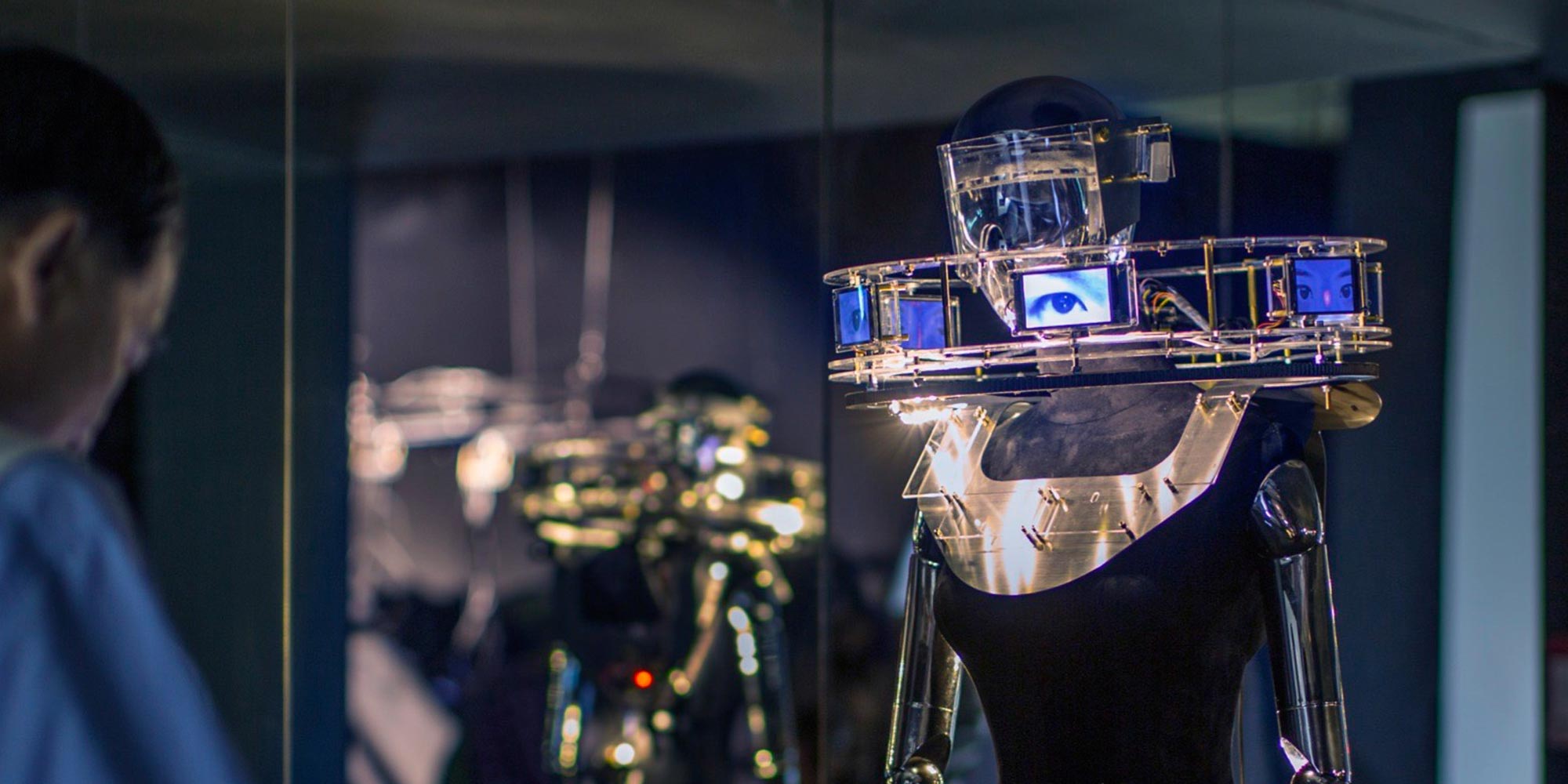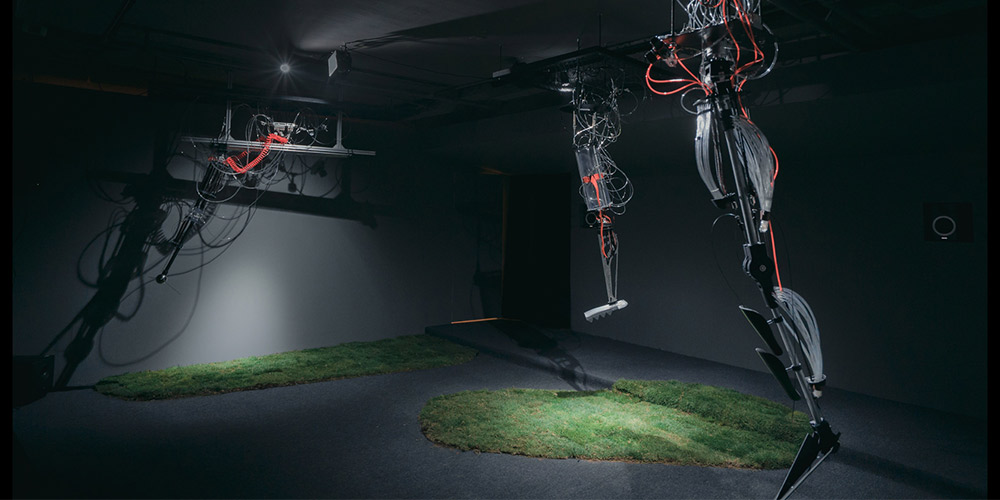What limits have we overcome thanks to our creativity and inventiveness? What consequences does this have for us, for our self-image and for the importance we attach to ourselves in the world? “human (un)limited” is the title of the current and second major exhibition project by Ars Electronica and Hyundai Motorstudio.
Type: Exhibition
Duration: From November 19, 2019, in Beijing, from November 22, 2019 in Seoul, from November 27, 2019 in Moscow
City, Country: Beijing, China / Seoul, South Korea / Moscow, Russia
Venues: Hyundai Motorstudio Beijing, 798 Art District, Beijing, China, Hyundai Motorstudio Seoul, 738 Eonju-ro, Nonhyeon-dong, Gangnam-gu, Seoul, Südkorea, Hyundai Motorstudio Moscow, New Arbat Ave, 21, стр.1, 121099 Moskau, Russland
A series of exhibitions by HYUNDAI MOTORSTUDIO and ARS ELECTRONICA
Homo Sapiens not only changed the world, he created his own world. In a very short time we humans have become the determining factor of all biological, geological and atmospheric changes on this planet. We have made the seemingly impossible possible. “human unlimited?” In the middle of the “Age of Man”, the Antropocene, this unprecedented success is in danger of faltering. No matter how boundless our power may be, the belief that we can put ourselves above nature is crumbling. For the more rigorously we subject the world to our creative will, the more precarious the problems we are confronted with become. It is becoming more and more urgent for us to act as a global community, but the borders, rifts and ditches between us that stand in the way of this cooperation are also becoming ever clearer. Human limited?
“human (un)limited“ is the second joint exhibition project of Hyundai Motorstudio and Ars Electronica, dedicated to the human success story and its possible next chapters. At the center of this artistic-scientific research are the people themselves, our weaknesses and strengths, and our eternal search for our place in the world. “human (un)limited” deals with the limits that we encounter as individuals and as a society, the limits that we impose on ourselves, and the limits that we seek to push out and overcome. In Beijing, Seoul and Moscow, three exhibitions will be presented simultaneously, bringing together artistic positions from China, Korea, Russia and the West and reflecting different cultural interpretations of the theme.
The project page of Hyundai.


Hyundai Motorstudio Beijing
Refik Anadol (TR/US)
Black Sea
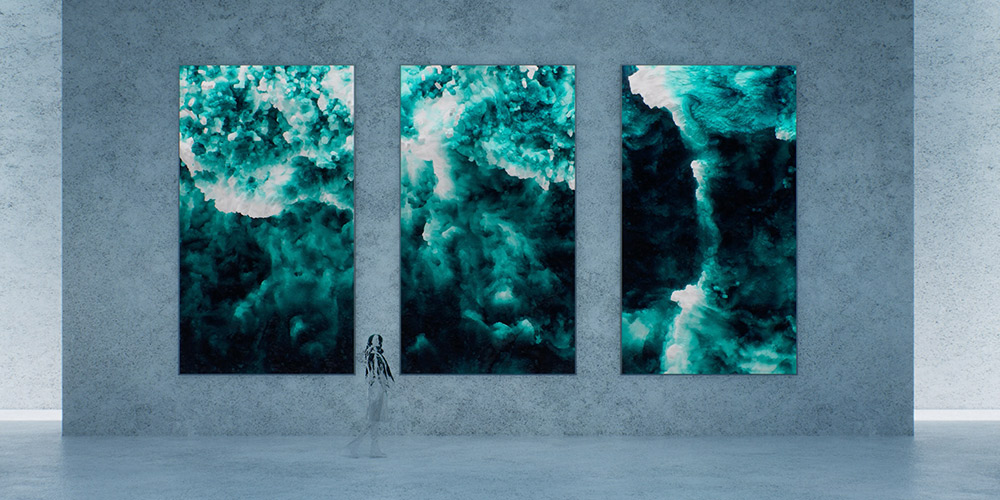
The relationship between simulation, reality, and the quest for understanding is largely a reflexive one. In the stories we tell and the worlds we build, we continually construct mirrors that offer meditations on our identity while simultaneously becoming a part of nature itself. As Philip K. Dick says, “Reality is that which doesn’t go away when you stop believing in it.” A simulation is that which doesn’t stop when the stories go away. Stories are responsible to our human desire for resolution, but a simulation is responsible only to its own laws and initializing conditions. A simulation has no moral, prejudice, or meaning. Like nature, it just is.
Black Sea is a kinetic data sculpture that explores the organic interaction between representation and reflection. Using high frequency radar collections of the Black Sea, this piece aims to highlight the symbiotic interplay of technology, art and nature in relation to humanity’s quest to push the limits of possibility. Our modes of representation and inquiry become a part of our natural world, reflecting and augmenting our perceptions of reality. In our quest for resolution, stories offer us a simulated environment that are in fact just as real as nature itself. Through the use of AI and other digital media, the artist transforms the practice of ‘data visualization’ into an aesthetic experience full of poetry and abstraction, making the invisible world of data tangible.
Credit: Refik Anadol Studio
Maja Smrekar (SI)
!brute_force
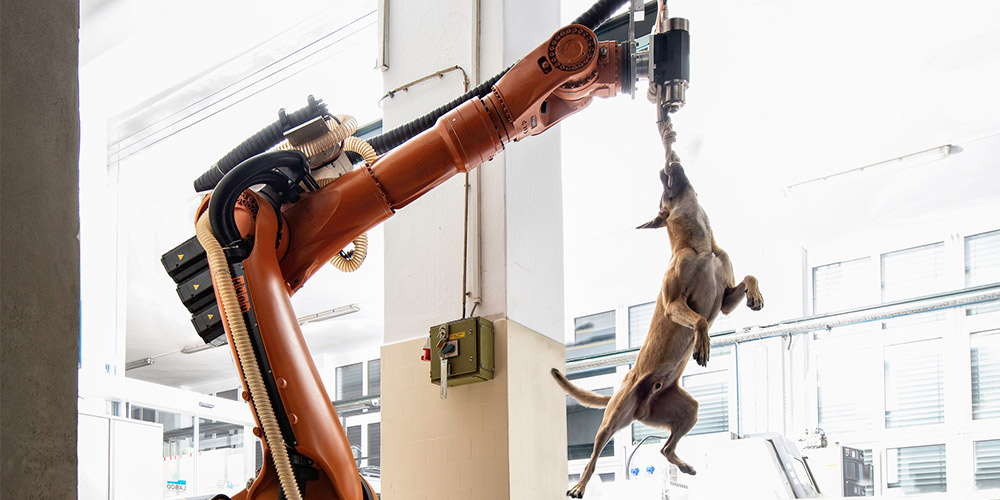
What can artificial intelligence learn from dogs? This is a question of practice-oriented artistic research aimed at developing an algorithm for artificial neural networks that is co-programmed by dogs. As we look at aspects of AI that challenge our social and political reality, the paradigm of techno-other and dog conception could open an alternative ontological window of knowledge about hybridity in life.
The premise of !brute_force is that technology should emancipate humans, since nature is no longer our reality and in recent decades our culture has been moving rapidly into the digital realm. There, computation reinforces our desires with programs that learn by gathering information about their environment and replaying their experiences. This behaviorist regime feels like a training method for managing life through order, where we need to learn an almost machine-like self-control in order to be allowed to regain the privilege of access to human conduct. Resistance to such conditions requires technological understanding which might lead to turning the system’s logic against itself.
This project therefore addresses the following context: even though we need technology, our present may not be limited to machines. Thus we are including other non-human entities and their cognitive mapping in the frame of re-thinking our place in the world.
www.majasmrekar.org/
Produced by Quo Artis Foundation (ES), Co-produced by Kapelica Gallery / Kersnikova Institute (SI), The Culture Yard / CLICK Festival (DK)
Aroussiak Gabrielian (US)
Posthuman Habitats
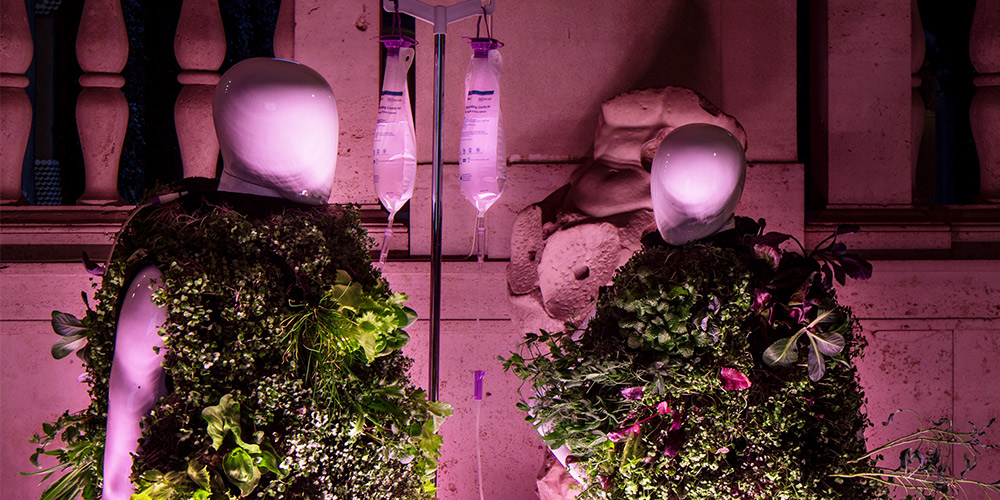
Posthuman Habitats is a recently prototyped speculative design project which imagines possible futures that integrate, serve, and advance more than just “Us.” The project responds to the future city’s impending food and water scarcity, dwindling green space in the face of hyper-densification, stresses on energy and water infrastructure, and the nomadic existence that characterizes our age of migration. The habitats are essentially cloaks of plant life that are intended to provide sustenance to the wearer, as well as flourish as expanding ecosystems that attract and integrate other animal and insect life.
Responding to theories of the “Posthuman,” distinctive subjects and environment are blurred and hybridized. As a wearable landscape system, it explores the blurred distinctions between nature-culture, human-machine, and celebrates hybrid ecologies and synthetic forms of nature that are representative of our technologically mediated experience. In particular, it comments on the complete end to romantic notions of “nature” and recognizes that even our bodies have become part of this deliberately engineered existence.
www.foreground-da.com/posthuman-habitats/
Credits: Aroussiak Gabrielian, Alison Hirsch, Grant Calderwood, Irene Tortora, Chris Behr
Shaun Hu (CN)
Internet of Everything: All Connections
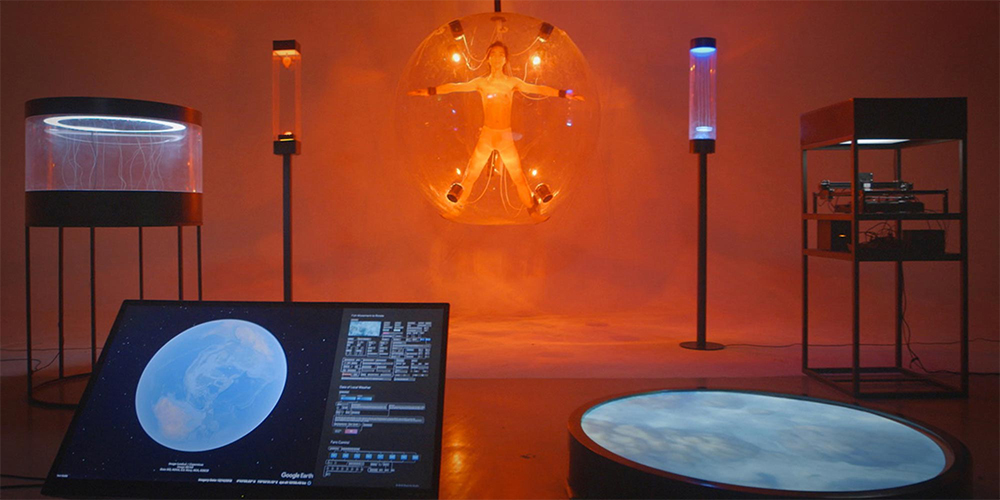
Internet of Everything: All Connections is a piece of work that connects human, animals, plants, bacteria, environment, compound and equipment using the Internet. It consists of seven parts, affecting each other one after another. There is no starting or ending point, since all parts are connected in an interlocking loop structure. This work constructs a chain reaction of a loop configuration to express the interconnected relationship between organisms, machines and nature using network connection.
What Hu Shuai is showing on a small scale, we are observing today on a global scale: whether climate crisis or extinction of species – our impact on the ecosystem of this planet causes far-reaching chain reactions with severe consequences, destroying more and more people’s livelihoods.
Zhang Yuyang (CN)
A -25°C Love Letter
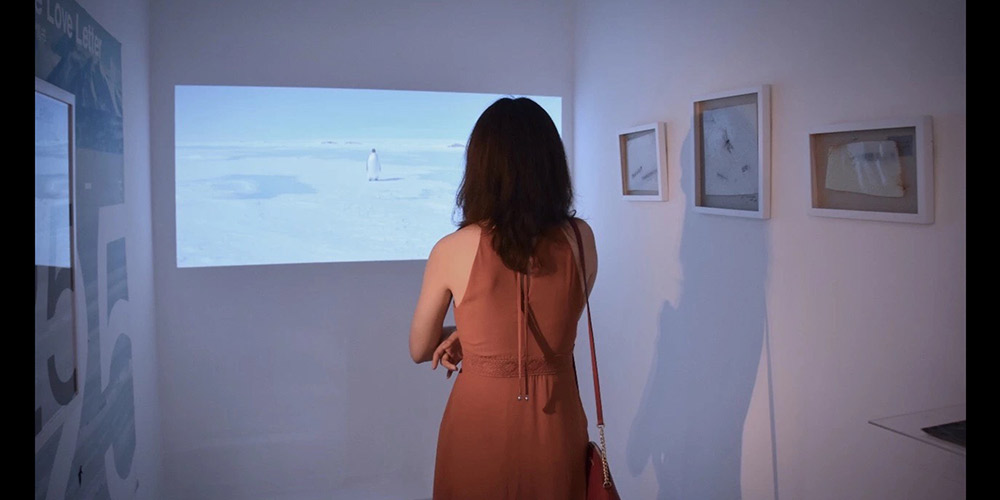
In this love letter, there is a loving but sad confession, which follows the plot where a penguin commits suicide. However, animals do not have the suicidal consciousness but human influence enables them to do so. The artist works some of the human emotions and consciousness into the plot as a way to convey her ideas. What is behind the romantic and holy scenes might be unwatchable truth, revelation or mutation.
Artwork Statement
x
Biographies
Name (CO) text
Artwork Credits & Acknowledgement
x
Youyang Song (CN)
Cooking New Materials
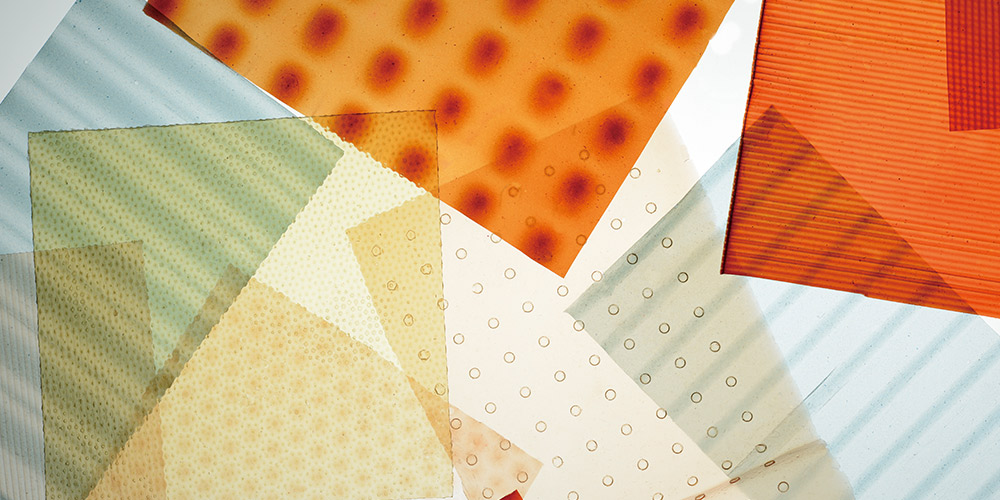
Cooking New Materials is based on a self-developed process to work with organic waste from the food industry in order to process it into new flexible, leather-like materials. The biomaterial offers similar toughness, durability and water resistance to normal leather materials. Banana and orange peel or soy milk residues are bonded with a natural binder as a matrix. The resulting bio-composite material can be easily reused after use by recooking.
Various manufacturing options such as laser cutting, embroidery, weaving, knitting, 3D printing and 3D modelling are also being tested, enabling to work with the biocomposite from various design and construction perspectives. This material offers new design possibilities due to the variety of processing possibilities and application areas, as well as a large commercial potential.
No matter how unlimited our power through technology might seem, the belief that we can place ourselves above nature has turned out to be mistaken. On the contrary, the more rigorously we disrupt our environment, the more precarious the problems we face become. By challenging the concept of nature versus technology, Youyang Song created a 100% “zero waste”natural product by following the principle of natures full cycle.
Ars Electronica Futurelab (AT)
ShadowGAN
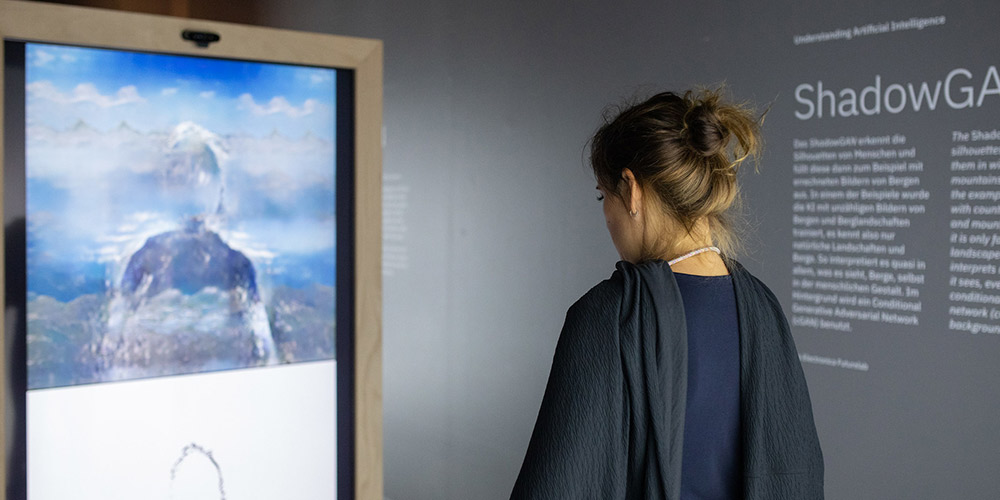
The ShadowGAN recognizes the silhouettes of people and then fills them in with generated pictures of mountains, for example. In one of the examples, the AI was trained with countless images of mountains and mountain landscapes, therefore only being familiar with natural landscapes and mountains. As a result it interprets mountains in everything it sees, even the human form. A conditional generative adversarial network (cGAN) is used in the background.
Machines, algorithms, and systems are already making all kinds of decisions easier for us, and in some cases even taking them off our hands. A team of researchers, artists, and developers from Ars Electronica Futurelab designed installations that explain how artificial intelligence actually works, aiming to demystify the technology behind it.
Bjørn Karmann (DK), Tore Knudsen (DK)
Project Alias
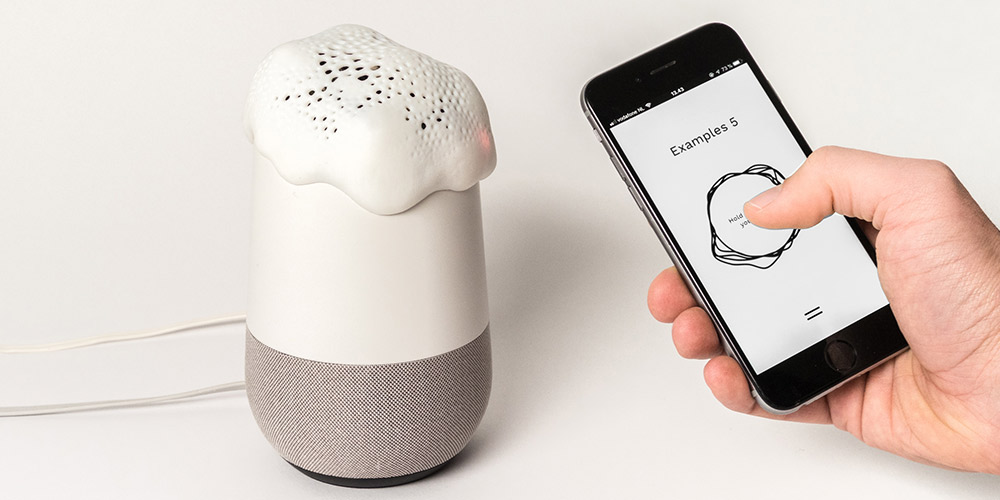
Rename your home assistant and make sure it never listens.
Grand Prize – Artistic Exploration: Awarded for artistic exploration and art works where appropriation by the arts has a strong potential to influence or alter the use, deployment or perception of technology.
Alias is a teachable parasite that is designed to give users more control over their smart assistants, both when it comes to customization and privacy. Through a simple app, the user can train Alias to react on a custom wake word/sound and, once trained, Alias can take control over your home assistant by activating it for you. When you don‘t use it, Alias will make sure the assistant is paralyzed and unable to listen by interrupting its microphones.
Our relationship with technology is formed by how we interact with it. However, commercial smart products for the home tend to treat the user as passive consumers. Especially smart home assistance has shown design patterns that limit the possibilities of interaction and agency from the user perspective, even in the most private and personal sphere—the home. Project Alias explores on how the power relation can be redefined, especially when it comes to privacy.
Cindy Hsin-Liu Kao (TW)
Duo Skin
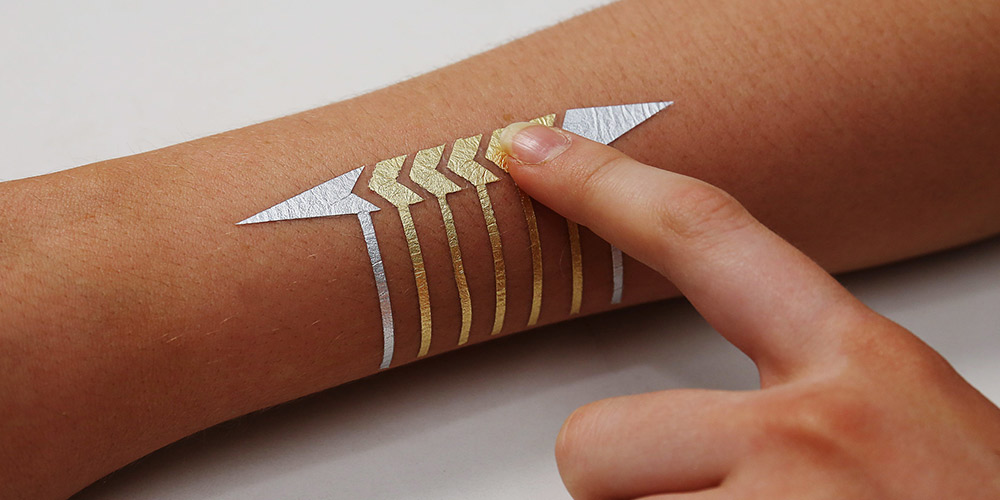
DuoSkin is a fabrication process that enables anyone to create customized functional devices that can be attached directly on their skin. Using gold metal leaf, a material that is cheap, skin-friendly, and robust for everyday wear, three types of on-skin interfaces are demonstrated: sensing touch input, displaying output, and wireless communication.
Drawing from the aesthetics found in metallic temporary tattoos , DuoSkin creates on-skin devices which resemble jewelry. Users can control their mobile devices, display and store information on their skin. The creators believe that in the future, on-skin electronics will no longer be black-boxed and mystified. Instead, they will converge towards the user friendliness, extensibility, and aesthetics of body decorations, forming a DuoSkin integrated to the extent that it has seemingly disappeared. And therefore, taking the process of blurring the line between technology and the human body even further.
duoskin.media.mit.edu/
Credit: Cindy Hsin-Liu Kao in collaboration with MIT Media Lab and Microsoft Research
Lin Yangfan (CN)
Post-factory era
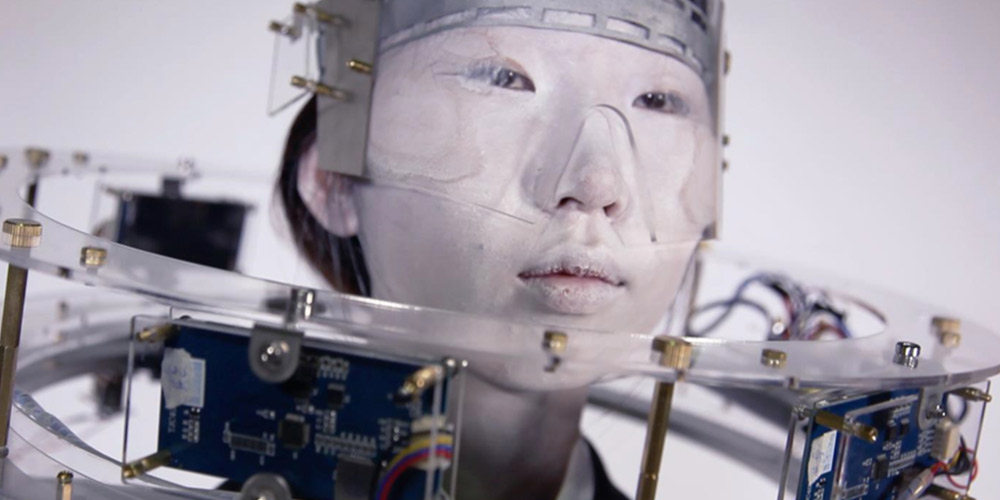
In a conceived work environment, workers will be required to wear human EEG monitoring equipment to detect brainwave data, and the data is converted to obtain the ratio of alpha and beta waves related to “attention”. Then, the “attention” brainwave signal is transmitted to the wearable Arduino through the Wi-Fi module in the human brain electrical signal monitoring device. The Arduino is used as a terminal to control five 3.2-inch liquid crystals that can be put on the terminal. When the staff is having a δ and θ band of brain waves, it is considered to be in the relaxation phase and the screen is displaying the eyes of the wearer. When the staff is not in the δ and θ bands of brain waves, they are considered to be focused. At this stage, the screen is closed. In this way, the data will ban the high-level jurisdiction behind the surveillance, and data monitoring will build a personal round prison without dead ends, and the laborer will fall into slavery under the data.
Lin Yangfan questions the increasingly constant observation and detailed evaluation of our daily behaviour. The striving for economic efficiency without limits turns technology into a tool for monitoring without limits.
Fei Jun (CN)
INTERESTING WORLD—INSTALLATION 2
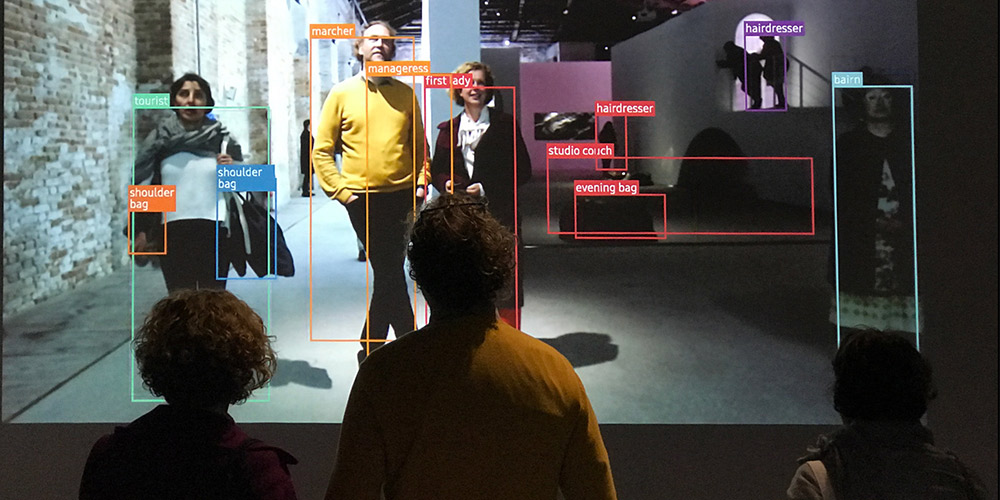
Installation 2 is a narrative device developed with artificial intelligence technology. Based on the semantic relevance ability of the machine, it generates a unique narrative as well as roaming experience based on the virtual earth for every audience on-site. It just like building countless invisible “bridges”, which connects the audience to any unknown person, object or scene that may be “relevant” in the world.
Dan Stavy (IL), Eran Weissenstern (IL), Mushon Zer-Aviv (IL)
The Normalizing Machine
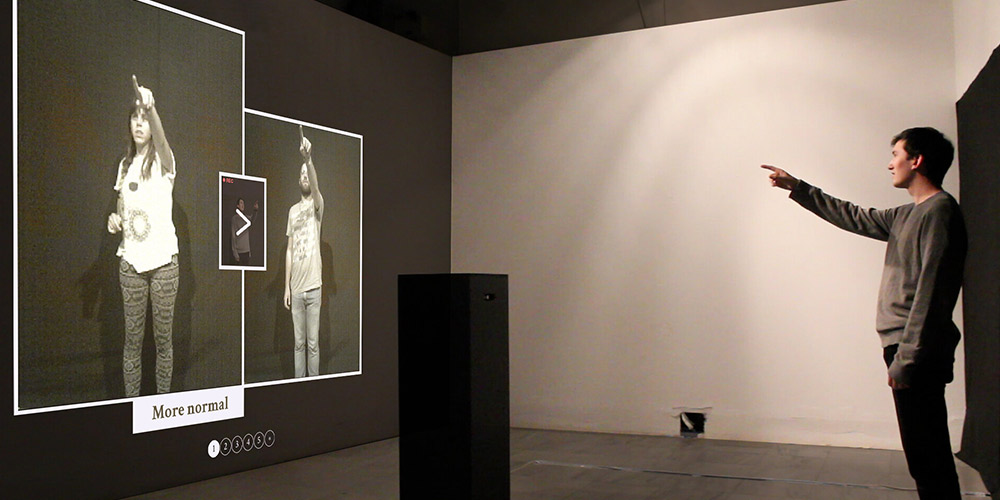
The Normalizing Machine is an interactive installation presented as an experimental research in machine-learning. It aims to identify and analyze the image of social normalcy. Each participant is asked to point out who looks most normal from a line up of previously recorded participants. The machine analyzes the participant decisions and adds them to its’aggregated algorithmic image of normalcy.
The installation visualizes how machine learning automates and amplifies the categorization of the normal and abnormal. As today’s systematic discrimination is aggregated and conveniently hidden behind a seemingly objective black box. With his Normalizing Machine Mushon Zer-Aviv asks who actually sets norms today and what role technologies such as AI systems play in this respect.
mushon.com/tnm/
Credit: The Normalizing Machine by Mushon Zer-Aviv. Software developed by Dan Stavy and Eran Weissenstern with additional help from Ingo Randolf using OpenFrameworks. Supported by Shenkar College, Print Screen Festival, Ars Electronica Festival.
Leon Baauw, Marcha Schagen (NL)
Project KOVR
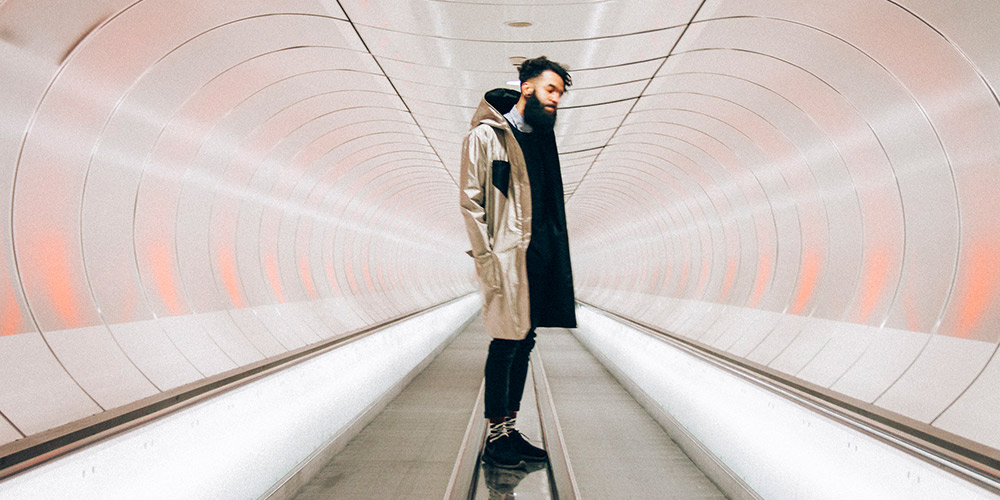
We humans are creating an enormous invisible network on top of our existing biosphere–the infosphere. The infosphere consists of networks and radio waves. lt’s our new, ever-expanding environment that is growing at a staggering rate. Yet we roam around unprotected with privacy-sensitive data, which might easily be tracked and misused by virtually anyone. We are not in control of our own privacy anymore. And privacy is what makes us human.
Clothing has always been a means to protect ourselves against the threats of the biosphere, and Project KOVR protects the individual from the infosphere. By testing and combining different layers of metalliferous fabrics, Dutch designers Schagen and Baauw found an effective solution to protect the individual and his/her everyday tech-devices from radio waves and radiation. The black pockets allow the wearer to still be reachable with their device of choice. Project KOVR is a wearable countermovement designed to regain control.
Based on the dystopian Idea of total surveillance and complete loss of any privacy, the designers are raising awareness on how much of our identity we want to share constantly and unknowingly through our data.
Adam Harvey (US)
VFRAME
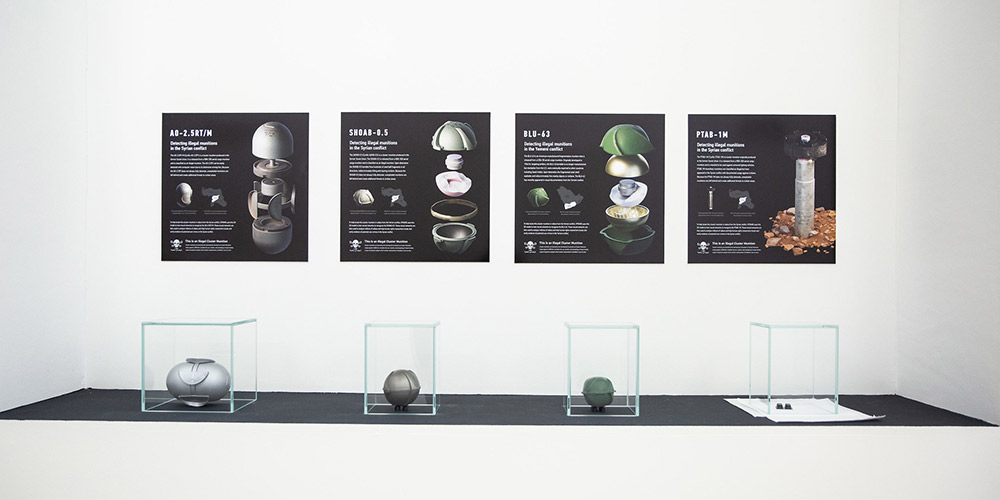
VFRAME is a computer vision toolkit designed for human rights researchers and investigative journalists. It provides customized state-of-the-art tools for object detection, visual search, and generating synthetic image training datasets. VFRAME is currently working with human rights researchers to analyze millions of videos from the Syrian, Yemeni, and Sudanese conflict. The computer vision toolkit along with the methodologies and API examples will all be published as open source material as the project develops further.
The main goals of this project are to provide innovative tools designed specifically for human rights researchers working with visual media from conflict zones. VFRAME also provides other computer vision developers with the open source neural networks used to locate illegal munitions.
Videos shared online to document war crimes, atrocities, and human rights violations are important sources of information for human rights researchers. Manually reviewing these videos is beyond our limits: it is expensive, does not scale, and can cause vicarious trauma. As an increasing number of videos are posted, a new approach is needed to understand these large datasets.
vframe.io/
Credit: VFRAME development is currently supported by a grant from the German Federal Ministry of Education and Research (BMBF).
Qiu Yu (CN)
The mechanically controlled eyes in the works see themselves in the mirror
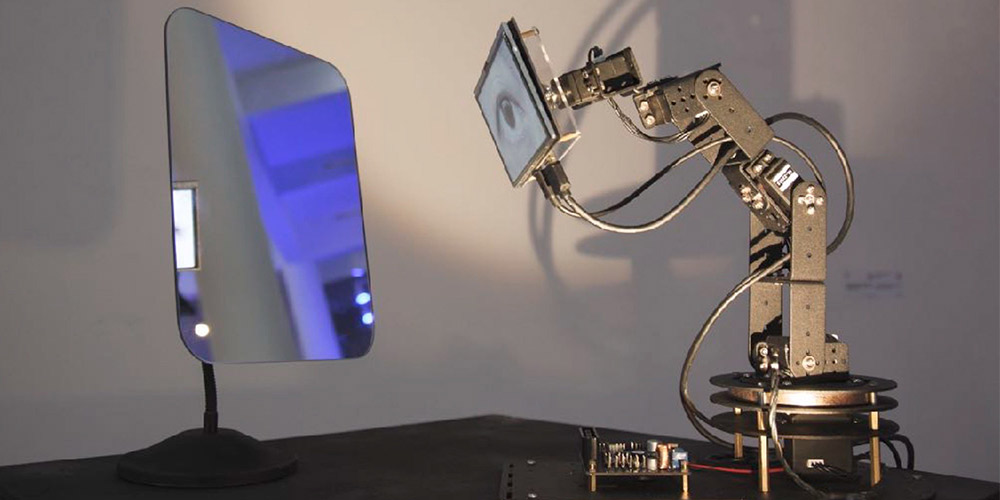
Do machines have consciousness? Will our body be replaced by machines one day? Is the replaced body still our own? The mechanically controlled eyes in the works see themselves in the mirror, re-emphasizing self and life in mutual gaze.
Today’s intelligent machines can recognize patterns; no more, no less. Whether we humans will ever (or should) succeed in developing artificial systems that have an intelligence that corresponds to ours is an open question.
Studio NOWHERE (CN)
The Experimental Prototype
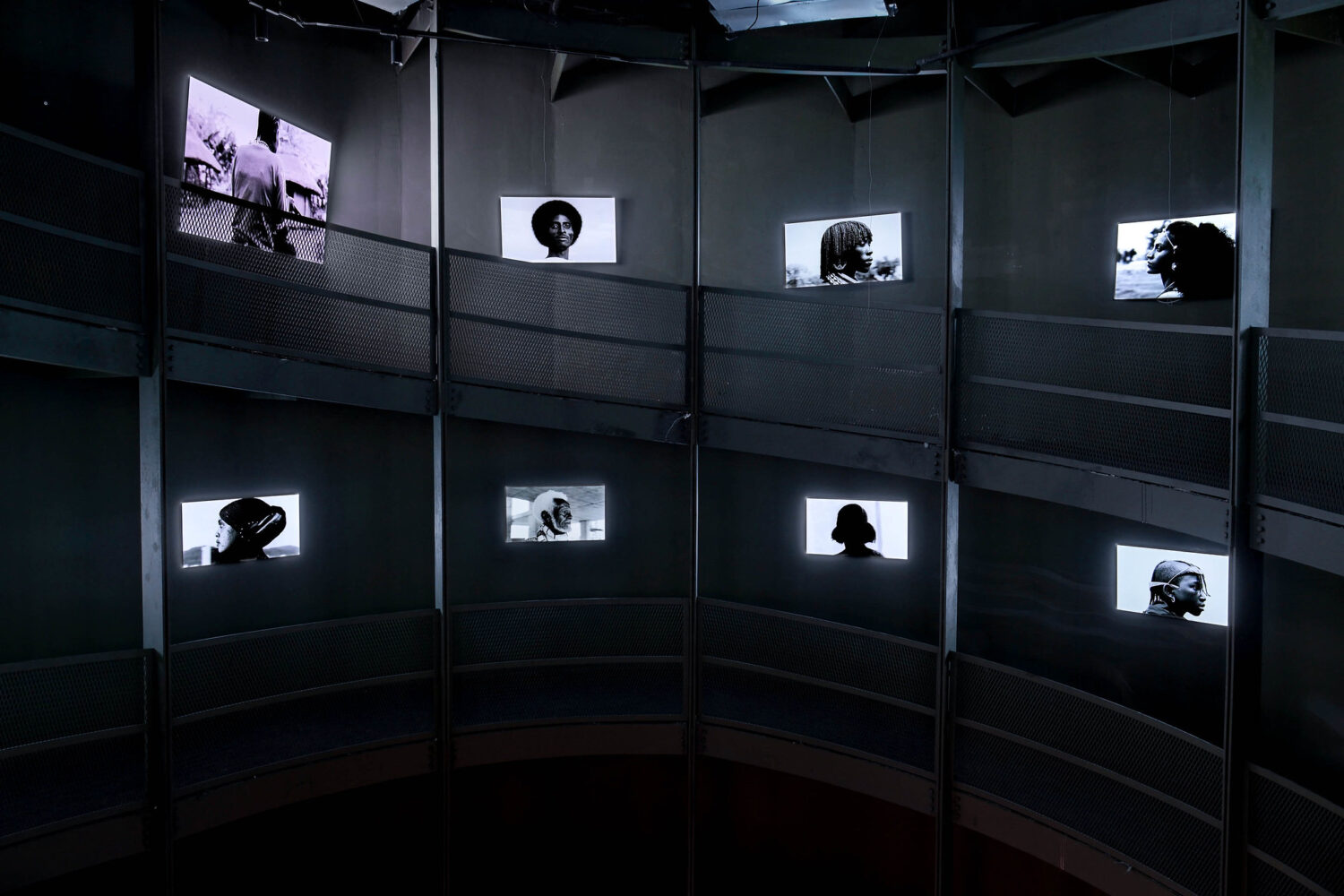
The Experimental Prototype of Project Golem #052019 (EPPG #052019) is an evolving concept developed by Studio NOWHERE. Based on the Studio’s early research projects (Project Golem*), the EPPG began with the investigation into a structure of a mechanical limb, using pneumatic devices and studio-made air muscles to convey the power of a football kicking movement for which the studio experimented with different designs from pneumatic structures to biomorphic mechanism.
With today’s technologies, we have reached a point where we can not only recreate body parts and functions but deeply adapt and alter the human body. Blurring the line between body and technology leaves us with the question: To what extent will we be dependent on our body enhancements in the future?

Hyundai Motorstudio Moscow
Egor Kraft
Selected Works

Egor Kraft works at the intersection of arts, media, technology, film, critical design and research. Egors work finds itself on the boundary between reality and its virtual misrepresentation, involving artificial information systems, computational technologies, films, interventions often in conjunction with traditional medias. As part of his research based practice he tends to develop speculative narratives questioning co-existence of human irrational reasoning and a ubiquitous impartial and quantitative orders rendered by machinic agency and technologies of today and tomorrow.
Structures of exponentially increasing capacities, synthetic intelligence, data monopolies as power structures, ubiquitous mechanic analysis and interpretation, planetary scale computation, techno-politics vs geopolitics, speculative crypto-economies, DNA design and genetic machine developments – all these and many other cognitive perspectives reconstitute the aspect of human and a new geological epoch.
In how far is the human aspect subject to technology? To what degree and from what viewpoint is the human aspect autonomous, unpredictable, faulty, irrational? How shall this human aspect coexist along with the precise ubiquitous machinic automated organisation? Having once seen the surface under a microscope, we will never again see it as we knew it before. How may we redefine the ‘human’ after seeing the world through the lens other synthetic forms of perception and thinking? Investigating this political, ethical, philosophical and aesthetic questions constitutes new challenges for artistic production, as a primordially ‘human’ project.

Hyundai Motorstudio Seoul
Ye Seung Lee (KR)
VARIABLE SCAPE

Innovative technologies—such as big data, Internet of Things (IoT), intelligence of things, artificial intelligence, robotics, and biotechnology—are rapidly outpacing our ability to understand the technology involved. Algorithms beyond our discernment affect the decisions we make. On such technological developments, response varies: some celebrate a life with more “smart,” while others are anxious of it becoming a threat to their jobs and thinking, and the time will come much sooner than later. I attempt to think about this contemporary period where utopia and dystopia coexist, filled with ambiguities and hybridities, throughmythological imagination inspired by Shan Hai Jing, or the Classics of the Mountains and Seas.
An ancient text from China on its ancient geography or myths, Shan Hai Jing is a record of written texts and illustrations by shamans and magicians who portray peculiar things, animals, tribes, local cultures, and geographical features of China. It is said that Jorge Luis Borges borrowed some stories from Shan Hai Jing for his book, Book of Imaginary Beings.
Unlike Greek and Roman mythology, Shan Hai Jing has no accurate historical lineage. It is characterized by the fact that its narrative is similar to a dot-like structure, dividing physical spaces between mountain (landscape), sea (seascape) and distant areas, without any distinction of age and place, normalities and abnormalities, and realities and unrealities.
This exhibition is an attempt to contemplate on the scapes of this era, of which the keywords are ambiguity and hybridity, and moreover, our future, through Shan Hai Jing’s main features with respect to the ambiguities of man and the other creators, relationship between human and non-human, and tactileness of virtuality and reality.
Curated by Fei Jun (Beijing), Martin Honzik (Senior Director Festival/Prix/EXPORT Ars Electronica)
Exhibition Design: ANY:TIME
Coordinate Curators: Christl Baur, Manuela Naveau
Project Manager: Isabella Kartusch, Xu Jing, Space Innovation, Artlab
Participating institutions
SPACE INNOVATION
Hyundai Motor Company’s Space Innovation creates exhibition contents by engaging customers with lots of programs and events at Hyundai Motorstudio, a brand experience space of Hyundai Motor Company. Based on the brand value of ‘Experimental Creation’, we provide inspiration to people through various attempts. Space Innovation will continue Art+Technology projects in cooperation with ARTLAB by collaborating with various artists across the globe, and also search for a partnership that can open new possibilities.
ARTLAB
Hyundai Motor ARTLAB communicates with people through the arts and prepares for the future beyond the corporate perspectives. Hyundai Motor Company has partnered with the National Museum of Contemporary Art in Seoul, Korea, Tate Modern Museum in London, UK, and Los Angeles County Museum of Art, the United States, for more than ten years in support of creative work by artists and curators. With the global art partners, such as Ars Electronica, we examine and envision the current and future integration of art and technology. ARTLAB continually contemplates and challenges on the values art can bring to the future beyond genres and borders.
Central Academy of Fine Arts
The Central Academy of Fine Arts (CAFA) is the only higher education arts academy directly under the Ministry of Education of China. CAFA is dedicated to a contemporary art education structure, with programs like Fine Art, Design, Architecture and Humanities interacting, supporting and influencing each other. CAFA plays a leading role in China’s art education system in the new century. With its distinctive Chinese features, advanced teaching and research resources, CAFA has received global recognition in the realm of art education, and has become a model school, representative of and leading China’s higher arts education.
Ars Electronica
Since 1979, Ars Electronica has been concerned with shaping the future and the impact of new technologies on our lives. Our attention is always focused on the role of human beings, the cultural and social challenges they face, and the resulting possibilities for shaping our lives. Ars Electronica has developed an internationally successful platform out of the trend-setting exchange and interplay of art, technology and society, which today encompasses a whole range of different activities.
1979_ Ars Electronica Festival / 1987_Prix Ars Electronica & Ars Electronica Archiv / 1996_Ars Electronica Center & Ars Electronica Futurelab / 2004_Ars Electronica EXPORT / 2009_Ars Electronica Center (Expansion) / 2013_Ars Electronica Solutions / 2016_Ars Electronica Japan
